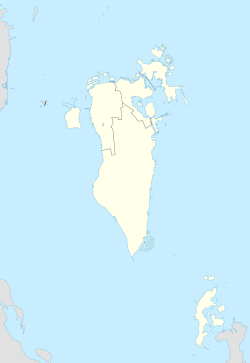Ain Umm Sujoor
Ain Umm Sujoor
موقع عين أم السجور | |
|---|---|
 The spring. | |
| Coordinates: 26°13′18.32″N 50°28′12.53″E / 26.2217556°N 50.4701472°E | |
| Country | |
| Governorate | Northern Governorate |
The Ain Umm Sujoor (Template:Lang-ar) is an archaeological site located in the village of Diraz, Bahrain. Believed to have been built during the 3rd millennium BC, the site consists of an oval hollow, approximately 60x30 meters, with two wells, several rooms and ovens. It has been largely neglected in recent times.

Etymology
The name of the well, Ain Umm Sujoor, translates from Arabic to 'Mother of the spring of overflowing waters'.[1]
History
The water wells date back to 3rd millennium BCE to the Dilmun period; rooms and ovens, located on the southern side of the wells, are believed to be later additions. The well on the north is called holy well, or water temple, which is named after discovering that a part of the structure was used to show peoples’ gratitude to their Gods for water.[1] The wells and the pool is believed to be a later addition.
Excavations
The site has been excavated by the Danish and Japanese expeditions in 1954 and 1990s respectively. [2] The Japanese team originated from Rikkyo University and discovered Wells 2 and 3 in addition to Well 1, and were the first to suggest the wells were holy places. [3]
See also
References
- ^ a b "Eternal Springs". Bahrain Authority for Culture and Antiquities. Archived from the original on 7 July 2018. Retrieved 6 July 2018.
- ^ Bibby, T. (2017) Tyrebrønden, Kuml, 4(4), s. 154-163. Accessed from https://tidsskrift.dk/kuml/article/view/97164
- ^ Matsumoto, Ken; Oguchi, Kazumi (2001). "Expeditions and Discoveries in West Asia by Japanese Archaeologists". Orient. 36 (1): 7–33. Retrieved 6 July 2018.

